ITINERARY
Highlights Of Laos – 5 Days / 4 Nights
- Vientiane Int’l Airport/ city transfer: 15 mn
Arrive in the morning – visa processing, then meet with guide for transfer to hotel.
Check in, then transfer to lunch with special Laotian dishes.
Vientiane is the capital and largest city of Laos, on the banks of the Mekong River near the border with Thailand. Vientiane became the capital in 1573 due to fears of a Burmese invasion but was later looted then razed to the ground in 1827 by the Siamese. Vientiane was the administrative capital during French rule and, due to economic growth in recent times, is now the economic center of Laos. The city had a population of 820,000 as at the 2015 Census.
Vientiane is noted as the home of the most significant national monument in Laos: That Luang, which is a known symbol of Laos and an icon of Buddhism in Laos. Other significant Buddhist temples in Laos can be found there as well, such as Haw Phra Kaew, which formerly housed the Emerald Buddha.
Lunch at arrival, then visits:
Pha That Luang is a gold-covered large Buddhist stupa in the centre of the city of Vientiane, Laos. Since its initial establishment, suggested to be in the 3rd century, the stupa has undergone several reconstructions as recently as the 1930s due to foreign invasions of the area. It is generally regarded as the most important national monument in Laos and a national symbol.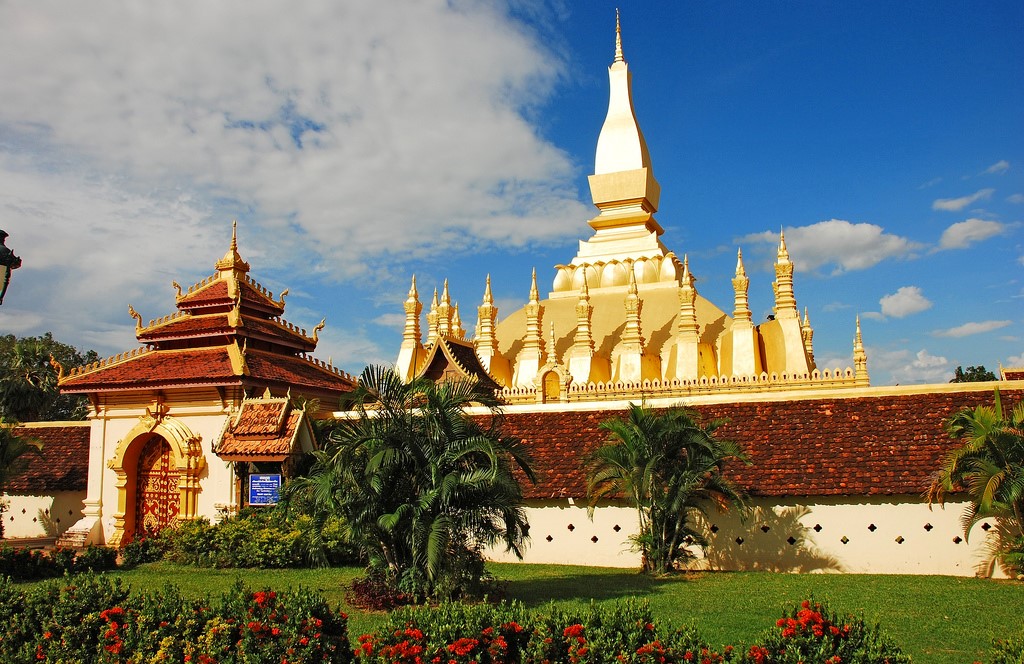
Transfer to hotel for check in.
Overnight in Vientiane.
- Vientiane city tour
Continue the visits at Vientiane.
Haw Phra Kaew, also written as Ho Prakeo, Hor Pha Keo and other similar spellings, is a former temple in Vientiane, Laos. It is situated on Setthathirath Road, to the southeast of Wat Si Saket. It was first built in 1565 to house the Emerald Buddha, but has been rebuilt several times. The interior now houses a museum of religious art and a small shop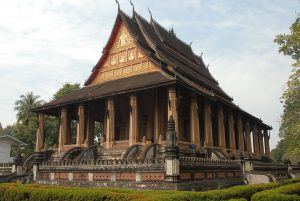
Haw Phra Kaew was built in 1565–1566 on the orders of of King Setthathirath after he moved the capital from Luang Prabang to Vientiane. The temple was built on the grounds of the royal palace to house the Emerald Buddha figurine.
Wat Sisaket is a Buddhist temple in Vientiane. It is situated on Lan Xang Road, on the northwest of Haw Phra Kaev.
Xieng Khuan Buddha Park
Sculpture garden housing over 200 Buddhist and Hindu sculptures
Buddha Park is a sculpture garden housing a collection of Buddhist and Hindu sculptures in a park like setting on the banks of the Mekong river outside Vientiane.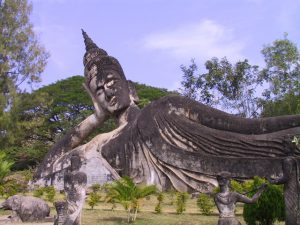
The park, also known as Xieng Khuan and Xiengkuane Buddha Park was built in 1958 by Luang Pu Bounleua Sulilat, a Laos national who later moved to Thailand where he created a similar park named Sala Keoku in Nong Khai, on the other side of the Mekong river.
Although often referred to as Wat Xiengkuane, Buddha Park is not a temple, even though some of its sculptures like a large reclining Buddha are worshipped by local Buddhists.
Sculptures of the Buddha, Hindu Gods, demons & mythological creatures
The park houses over 200 sculptures made from concrete in varying sizes from small to very large. The sculptures of the Buddha, several Hindu Gods, demons and mythological creatures like a three headed elephant are pretty weathered, giving them an impression of being old.
One of the most striking sculptures is a giant pumpkin with three floors. At the front is a large mythological creature, its open mouth serving as the entrance. Its three floors represent Hell, Earth and Heaven. A staircase inside the pumpkin leads to the platform on top, from where good views of the park can be had.
Talat Sao is both a shopping mall (with air-conditioning) and morning market in central Vientiane. Its outdoor section has narrow walkways lined with market-style souvenir stalls, while the mall spans 5 floors, housing shops, banks, and currency exchange services.
The shopping mall is where you can shop for clothes, sports equipment, and jewellery. There’s also a cinema and arcade centre, both popular among those looking to escape the heat and humidity.
Head to the 4th floor to find a large food court, where you can enjoy a wide range of local and international dishes.
Dinner at 4th Floor Talat Sao.
Overnight in Vientiane
- Luang Prabang/ hotel transfer: 20 mn
Transfer to lunch before leaving for flight to Luang Prabang.
Arrival at Luang Prabang Int’l Airport – visa processing, then meet with guide for transfer to hotel.
Transfer to a local restaurant for lunch to enjoy a fresh and tasteful menu of Lao dishes, then to hotel for check in.
Overnight in Luang Prabang.
- Road transfer to Pak Ou Caves, boating on Mekong & Nam Ou rivers, handicrafts villages visits.
Breakfast at your hotel.
Luang Prabang was recognized by UNESCO as a world cultural heritage mostly because of the unique historical value of this royal city, where it witnessed the rule of 63 kings. Besides, the city is also a magnificent and mysterious Buddhist centre with thousands of temples, many of which are beautiful architectural accents, gilded with golden paint.
Not only that, Luang Prabang is also a peaceful, charming small city nestled on the green, poetic Mekong River and Nam Khan, surrounded by rolling mountains of clouds all year round.
In the past, this city was chosen to be the capital of the Lan Xang empire - the first kingdom of Laos (1350-1545). In the 16th century, although the capital was moved to Vientiane, Luang Prabang preserved its position as the cradle of Laos' diverse culture.
Luang Prabang is also a place to preserve the heritage of art and architecture: over 30 magnificent palaces, most built from the 14th century; about 40 ancient temples were built from different dynasties, each of which is a cultural work of high artistic value. Hundreds of antique wooden houses are designed in a very beautiful style, arranged in an orderly manner along the long and small streets, creating a lovely and still image.
The 1st visit is the former Royal Palace, now the National Museum where you will explore the history of Laos.

The Royal Palace Museum in Luang Prabang (also known as “Haw Kham” or "Golden Hall") was once Laos’ Royal Palace. It houses a lot of interesting historical items. Every item tells a story...so you will learn quite a lot about Lao history and about Laos’ royal.
Built in 1904, it features a blend of Lao traditional and French style. It was built for King Sisavang Vong and his family during the French colonial era.
After the death of King Sisavang Vong, the crown Prince Savang Vatthana and his family were the last to occupy the palace. After the revolution in 1975, the building was taken over by the government. The palace was then converted into a national museum and opened to the public in 1995.
Located in the city just the other side of the road from Phousi mountain, the palace is in walking distance of all main hotels and guest houses.
In the palace compound, there are several buildings to visit.
Transfer to the pier & embark for a boat trip for approximately 2 hours and 40 minutes to visit: Pak Ou Caves, Ban Khok Village & Ban Hatkam Village (surnamed Whisky Village)
The Pak Ou Caves are filled with thousands of Buddha statues, set in a rocky cliff face overlooking the Mekong River. They’re located around 25 kilometers from Luang Prabang in Northern Laos. There are two caves: a lower cave not too far from the river level, and an upper cave that’s a steep 5-10-minute climb up stone steps.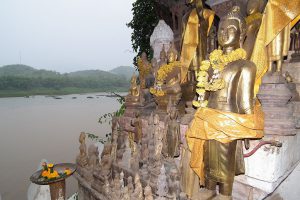
On the way, stop to visit the holy Pak Ou caves. The caves themselves are very close to the confluence of the Nam Ou and Mekong Rivers, hence the name Pak Ou. In these 2 caves are displayed hundreds of sacred centuries-old Buddha images which are the object of pilgrimages during the Lao New Year festivities around mid-April.
Continue the boat trip on Nam Ou River to visit Ban Sang Hay Village, a non-touristic village, where people live with simple way of life. Here you will see how local people produce traditionally liquor from sticky rice or Lao whiskey.
Boat back to the pier, then route transfer back to city for lunch.
On the way back, stop at the weaving village of Ban Xang Khong specialised for many years in manufacturing and selling products made from silk and Saa Paper (paper made from the bark of the Saa Tree).
Visit Wat Xiengthong - an ancient royal temple built in 1560 and Wat May with 5-layer thick roofed tiles. They are two of the many beautiful tombs with excellent architectural features and decorative details. Wat Xiengthong has rich wood carvings and decorations.
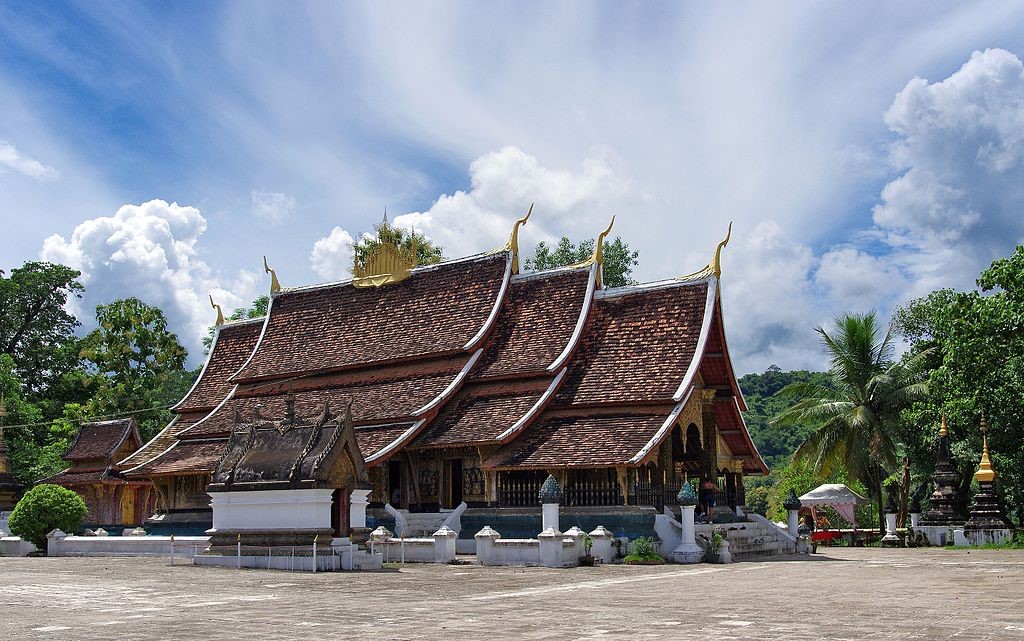
At the end of afternoon, ascent to Mount Phou Si for sunset to enjoy the terrific 360° panorama of Luang Prabang. The top of Mount Phousi is the perfect spot for a sunset and vantage point of Luang Prabang Town, Phan Phao temple, Mekong River and Nam Son River from here. One of the city's roofs that visitors can see from above Phousi is the royal tombs of the past - the impressive double cross in the combination of sophisticated architectural details of Laos and France. Now these tombs have become museums with many precious artifacts.
Back to the city for dinner.
After dinner, you can visit the hill tribe evening market for some shopping. This colorful market takes place every evening from around 5pm along the main streets of town and is a great place to look for souvenirs.
Overnight in Luang Prabang.
- Early morning offerings, morning market
At sunrise, your guide will join you at your hotel to accompany you and to explain the daily singular ritual of the Morning Alms (Sai Bat) to the monks.
Sai Bat (Morning Alms) is a longstanding tradition in Laos Buddhist culture. In observing it, the devoted offer food to monks throughout the Luang Prabang every morning. This is sustenance for the monks, so great care is taken in preparation (and visitors wishing to take part should follow guidelines to ensure that they make appropriate offerings).
Each morning, starting at around 05:30, saffron-robed monks and novices emerge onto the streets with their alms bowls (‘bat’). Awaiting them are Lao people who have already taken the time to prepare sticky rice and other foods; they will place a portion in the bowl of each monk who passes by. The ceremony is undertaken in complete silence.
The cultural significance and austere beauty of Sai Bat has made it a very popular tourist attraction in Luang Prabang. Most visitors witness the ceremony in the old city centre, along Sakkaline Road in particular.
Then you will pace the morning market where all the ethnic groups around are gathering back the products of hunting, fishing and gathering.
Return to your hotel for breakfast and check out.
Free time at leisure until transfer to airport for departure flight /or/ other destination.
